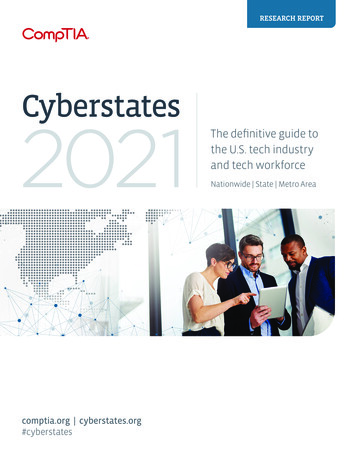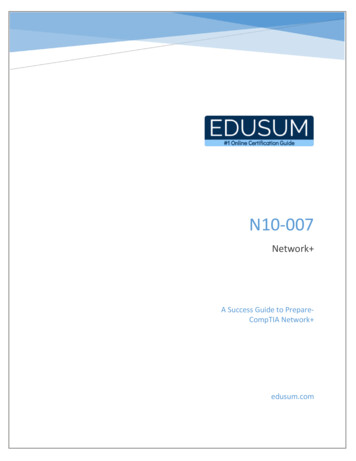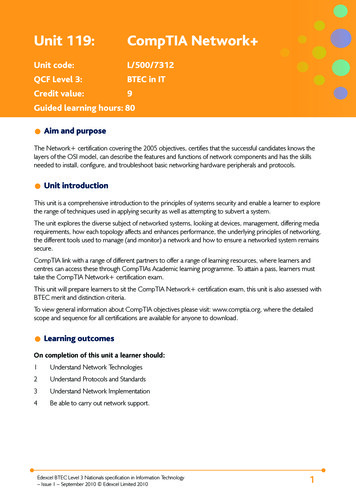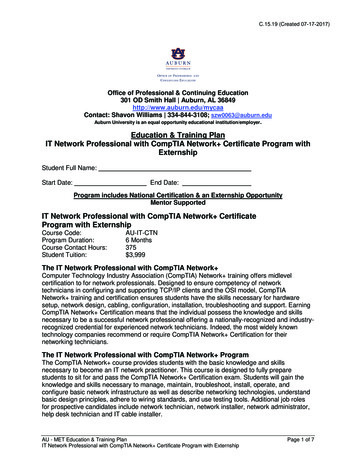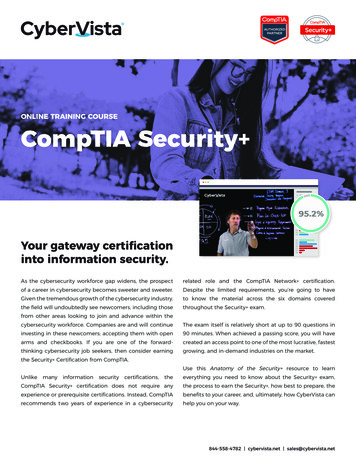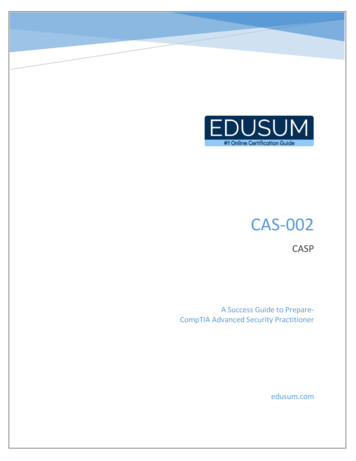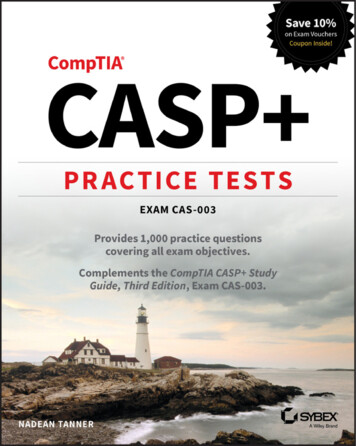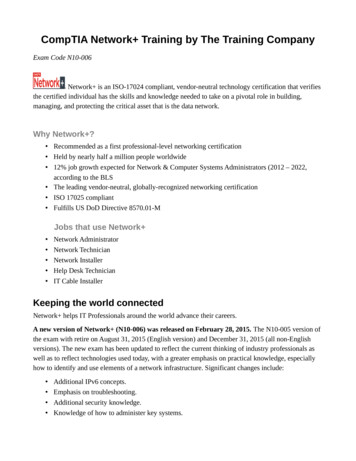
Transcription
CompTIA Network Training by The Training CompanyExam Code N10-006Network is an ISO-17024 compliant, vendor-neutral technology certification that verifiesthe certified individual has the skills and knowledge needed to take on a pivotal role in building,managing, and protecting the critical asset that is the data network.Why Network ? Recommended as a first professional-level networking certification Held by nearly half a million people worldwide 12% job growth expected for Network & Computer Systems Administrators (2012 – 2022,according to the BLS The leading vendor-neutral, globally-recognized networking certification ISO 17025 compliant Fulfills US DoD Directive 8570.01-MJobs that use Network Network AdministratorNetwork TechnicianNetwork InstallerHelp Desk TechnicianIT Cable InstallerKeeping the world connectedNetwork helps IT Professionals around the world advance their careers.A new version of Network (N10-006) was released on February 28, 2015. The N10-005 version ofthe exam with retire on August 31, 2015 (English version) and December 31, 2015 (all non-Englishversions). The new exam has been updated to reflect the current thinking of industry professionals aswell as to reflect technologies used today, with a greater emphasis on practical knowledge, especiallyhow to identify and use elements of a network infrastructure. Significant changes include: Additional IPv6 concepts.Emphasis on troubleshooting.Additional security knowledge.Knowledge of how to administer key systems.
The main differences between CompTIA Network N10-005 and Network N10-006 are thefollowing: Updated terms and technologies in the IT networking field. More hands-on experiences such as installing, configuring, implementing, managing andtroubleshooting. Three new topics: Compare and contrast physical security controls. Summarize basic forensic concepts. Summarize safety practices.Companies such as Dell, HP, Ricoh, Sharp and Xerox recommend or require CompTIA Network fortheir networking technicians. It is also a technical prerequisite option for IT technicians seeking to jointhe Apple Consultants Network, and is recognized by the U.S. Department of Defense.The CompTIA Network ce program is included in the scope of this accreditation, and may be keptcurrent through the CompTIA Continuing Education program.Test DetailsExam CodesLaunch DateNumber ofQuestionsType of QuestionsLength of TestPassing 05JK0-019 (for CompTIA AcademyPartners only)N10-006JK0-023 (for CompTIA AcademyPartners only)1-Dec-1128-Feb-15Maximum of 100 questionsMaximum of 90 questionsMultiple choice and performance-based Multiple choice and performance-based90 Minutes90 Minutes720 (on a scale of 100-900)720 (on a scale of 100-900) CompTIA A Certification CompTIA A Certification (9) months of networking (9) months of networkingexperienceexperienceEnglish, Japanese, German, SimplifiedChinese, Korean, Spanish, TraditionalChineseEnglish Version 8/31/2015All other languages: 12/31/2015English at launch (2/28/15) Japaneseand German - in developmentTBD - Usually three years after launch
Certification ExamObjectives: N10-006INTRODUCTIONThe CompTIA Network certification is an internationally recognized validation of the technicalknowledge required of foundation-level IT network practitioners.Test Purpose: This exam will certify that the successful candidate has the knowledge and skillsrequired to troubleshoot, configure, and manage common network wireless and wired devices,establish basic network design and connectivity, understand and maintain network documentation,identify network limitations and weaknesses, and implement network security, standards, andprotocols. The candidate will have a basic understanding of emerging technologies includingunified communications, mobile, cloud, and virtualization technologies.CompTIA Network is accredited by ANSI to show compliance with the ISO 17024 Standard and,as such, undergoes regular reviews and updates to the exam objectives.It is recommended for CompTIA Network candidates to have the following: CompTIA A certification or equivalent knowledge, though CompTIA A certification is not required. Have at least 9 to 12 months of work experience in IT networking.The table below lists the domains measured by this examination and the extent to whichthey are represented. CompTIA Network exams are based on these objectives.Domain1.0 Network architecture2.0 Network operations3.0 Network security4.0 Troubleshooting5.0 Industry standards, practices, and network theoryTotal% of Examination22%20%18%24%16%100%CompTIA Network Certification Exam ObjectivesV.5Copyright 2014 by the Computing Technology Industry Association. All rights reserved.The CompTIA Network Certification Exam Objectives are subject to change without notice.1 of 33
CompTIA Authorized Materials Use PolicyCompTIA Certifications, LLC is not affiliated with and does not authorize, endorse or condone utilizingany content provided by unauthorized third-party training sites, aka 'brain dumps'. Individuals who utilizesuch materials in preparation for any CompTIA examination will have their certifications revoked and besuspended from future testing in accordance with the CompTIA Candidate Agreement. In an effort to moreclearly communicate CompTIA’s exam policies on use of unauthorized study materials, CompTIA directsall certification candidates to the CompTIA Certification Exam Policies testingcenters/policies.aspxPlease review all CompTIA policies before beginning the study process for any CompTIA exam.Candidates will be required toabide by the CompTIA Candidate g/testingcenters/policies/agreement.aspx) at the time of examdelivery.If a candidate has a question as to whether study materials are considered unauthorized (aka brain dumps),he/she should perform a search using CertGuard'sengine, found here:http://www.certguard.com/search.aspOr verify against this tingcenters/policies/unauthorized.aspx**Note: The lists of examples provided in bulleted format below each objective are not exhaustive lists.Other examples of technologies, processes or tasks pertaining to each objective may also be included on theexam although not listed or covered in this objectives document.CompTIA is constantly reviewing the content of our exams and updating test questions to be sure ourexams are current and the security of the questions is protected. When necessary, we will publish updatedexams based on existing exam objectives. Please know that all related exam preparation materials will stillbe valid.(A list of acronyms used in these objectives appears at the end of this document.)CompTIA Network Certification Exam ObjectivesV.5Copyright 2014 by the Computing Technology Industry Association. All rights reserved.The CompTIA Network Certification Exam Objectives are subject to change without notice.2 of 33
1.0Network architecture1.1 Explain the functions and applications of various network devices Router Switch Multilayer switch Firewall HIDS IDS/IPS Access point (wireless/wired) Content filter Load balancer Hub Analog modem Packet shaper VPN concentrator1.2 Compare and contrast the use of networking services and applications VPNo Site to site/host to site/host to hosto Protocols IPsec GRE SSL VPN PTP/PPTP TACACS/RADIUS RAS Web services Unified voice services Network controllers1.3 Install and configure the following networking services/applications DHCPo Static vs dynamic IP addressingo Reservationso Scopeso Leaseso Options (DNS servers, suffixes)o IP helper/DHCP relay DNSo DNS serverso DNS records (A, MX, AAAA, CNAME, PTR)o Dynamic DNSCompTIA Network Certification Exam ObjectivesV.5Copyright 2014 by the Computing Technology Industry Association. All rights reserved.The CompTIA Network Certification Exam Objectives are subject to change without notice.3 of 33
Proxy/reverse proxyNATo PATo SNATo DNATPort forwarding1.4 Explain the characteristics and benefits of various WAN technologies Fibero SONETo DWDMo CWDM Frame relay Satellite Broadband cable DSL/ADSL ISDN ATM PPP/Multilink PPP MPLS GSM/CDMAo LTE/4Go HSPA o 3Go Edge Dialup WiMAX Metro-Ethernet Leased lineso T-1o T-3o E-1o E-3o OC3o OC12 Circuit switch vs packet switch1.5 Install and properly terminate various cable types and connectors using appropriatetools Copper connectorso RJ-11o RJ-45o RJ-48Co DB-9/RS-232o DB-25CompTIA Network Certification Exam ObjectivesV.5Copyright 2014 by the Computing Technology Industry Association. All rights reserved.The CompTIA Network Certification Exam Objectives are subject to change without notice.4 of 33
o UTP couplero BNC couplero BNCo F-connectoro 110 blocko 66 blockCopper cableso Shielded vs unshieldedo CAT3, CAT5, CAT5e, CAT6, CAT6ao PVC vs plenumo RG-59o RG-6o Straight-through vs crossover vs rolloverFiber connectorso STo SCo LCo MTRJo FCo Fiber couplerFiber cableso Single modeo Multimodeo APC vs UPCMedia converterso Single mode fiber to Etherneto Multimode fiber to Etherneto Fiber to coaxialo Single mode to multimode fiberToolso Cable crimperso Punch down toolo Wire stripperso Snipso OTDRo Cable certifier1.6 Differentiate between common network topologies Mesho Partialo Full Bus Ring Star HybridCompTIA Network Certification Exam ObjectivesV.5Copyright 2014 by the Computing Technology Industry Association. All rights reserved.The CompTIA Network Certification Exam Objectives are subject to change without notice.5 of 33
-to-peer1.7 Differentiate between network infrastructure implementations WAN MAN LAN WLANo Hotspot PANo Bluetootho IRo NFC SCADA/ICSo ICS servero DCS/closed networko Remote terminal unito Programmable logic controller Medianetso VTC ISDN IP/SIP1.8 Given a scenario, implement and configure the appropriate addressing schema IPv6o Auto-configuration EUI 64o DHCP6o Link localo Address structureo Address compressiono Tunneling 6to4, 4to6 Teredo, miredo IPv4o Address structureo Subnettingo APIPAo Classful A, B, C, Do Classless Private vs public NAT/PAT MAC addressing MulticastCompTIA Network Certification Exam ObjectivesV.5Copyright 2014 by the Computing Technology Industry Association. All rights reserved.The CompTIA Network Certification Exam Objectives are subject to change without notice.6 of 33
UnicastBroadcastBroadcast domains vs collision domains1.9 Explain the basics of routing concepts and protocols Loopback interface Routing loops Routing tables Static vs dynamic routes Default route Distance vector routing protocolso RIP v2 Hybrid routing protocolso BGP Link state routing protocolso OSPFo IS-IS Interior vs exterior gateway routing protocols Autonomous system numbers Route redistribution High availabilityo VRRPo Virtual IPo HSRP Route aggregation Routing metricso Hop countso MTU, bandwidtho Costso Latencyo Administrative distanceo SPB1.10 Identify the basics elements of unified communication technologies VoIP Video Real time serviceso Presenceo Multicast vs unicast QoSo DSCPo COS Deviceso UC serversCompTIA Network Certification Exam ObjectivesV.5Copyright 2014 by the Computing Technology Industry Association. All rights reserved.The CompTIA Network Certification Exam Objectives are subject to change without notice.7 of 33
ooUC devicesUC gateways1.11 Compare and contrast technologies that support cloud and virtualization Virtualizationo Virtual switcheso Virtual routerso Virtual firewallo Virtual vs physical NICso Software defined networking Storage area networko iSCSIo Jumbo frameo Fibre Channelo Network attached storage Cloud conceptso Public IaaS, SaaS, PaaSo Private IaaS, SaaS, PaaSo Hybrid IaaS, SaaS, PaaSo Community IaaS, SaaS, PaaS1.12 Given a set of requirements, implement a basic network List of requirements Device types/requirements Environment limitations Equipment limitations Compatibility requirements Wired/wireless considerations Security considerations2.0 Network operations2.1 Given a scenario, use appropriate monitoring tools Packet/network analyzer Interface monitoring tools Port scanner Top talkers/listeners SNMP management softwareo Trapo Geto Walko MIBS Alertso Emailo SMSCompTIA Network Certification Exam ObjectivesV.5Copyright 2014 by the Computing Technology Industry Association. All rights reserved.The CompTIA Network Certification Exam Objectives are subject to change without notice.8 of 33
Packet flow monitoringSYSLOGSIEMEnvironmental monitoring toolso Temperatureo HumidityPower monitoring toolsWireless survey toolsWireless analyzers2.2 Given a scenario, analyze metrics and reports from monitoring and trackingperformance tools Baseline Bottleneck Log management Graphing Utilizationo Bandwidtho Storageo Network device CPUo Network device memoryo Wireless channel utilization Link status Interface monitoringo Errorso Utilizationo Discardso Packet dropso Interface resetso Speed and duplex2.3 Given a scenario, use appropriate resources to support configuration management Archives/backups Baselines On-boarding and off-boarding of mobile devices NAC Documentationo Network diagrams (logical/physical)o Asset managemento IP address utilizationo Vendor documentationo Internal operating procedures/policies/standards2.4 Explain the importance of implementing network segmentation SCADA systems/Industrial control systemsCompTIA Network Certification Exam ObjectivesV.5Copyright 2014 by the Computing Technology Industry Association. All rights reserved.The CompTIA Network Certification Exam Objectives are subject to change without notice.9 of 33
Legacy systemsSeparate private/public networksHoneypot/honeynetTesting labLoad balancingPerformance optimizationSecurityCompliance2.5 Given a scenario, install and apply patches and updates OS updates Firmware updates Driver updates Feature changes/updates Major vs minor updates Vulnerability patches Upgrading vs downgradingo Configuration backup2.6 Given a scenario, configure a switch using proper features VLANo Native VLAN/Default VLANo VTP Spanning tree (802.1d)/rapid spanning tree (802.1w)o Floodingo Forwarding/blockingo Filtering Interface configurationo Trunking/802.1qo Tag vs untag VLANso Port bonding (LACP)o Port mirroring (local vs remote)o Speed and duplexingo IP address assignmento VLAN assignment Default gateway PoE and PoE (802.3af, 802.3at) Switch managemento User/passwordso AAA configurationo Consoleo Virtual terminalso In-band/Out-of-band management Managed vs unmanagedCompTIA Network Certification Exam ObjectivesV.5Copyright 2014 by the Computing Technology Industry Association. All rights reserved.The CompTIA Network Certification Exam Objectives are subject to change without notice.10 of 33
2.7 Install and configure wireless LAN infrastructure and implement the appropriatetechnologies in support of wireless capable devices Small office/home office wireless router Wireless access pointso Device densityo Roamingo Wireless controllers VLAN pooling LWAPP Wireless bridge Site surveyso Heat maps Frequencieso 2.4 Ghzo 5.0 Ghz Channels Goodput Connection typeso 802.11a-hto 802.11g-ht Antenna placement Antenna typeso Omnidirectionalo Unidirectional MIMO/MUMIMO Signal strengtho Coverageo Differences between device antennas SSID broadcast Topologieso Adhoco Mesho Infrastructure Mobile deviceso Cell phoneso Laptopso Tabletso Gaming deviceso Media devices3.0 Network security3.1 Compare and contrast risk related concepts Disaster recovery Business continuityCompTIA Network Certification Exam ObjectivesV.5Copyright 2014 by the Computing Technology Industry Association. All rights reserved.The CompTIA Network Certification Exam Objectives are subject to change without notice.11 of 33
Battery backups/UPSFirst respondersData breachEnd user awareness and trainingSingle point of failureo Critical nodeso Critical assetso RedundancyAdherence to standards and policiesVulnerability scanningPenetration testing3.2 Compare and contrast common network vulnerabilities and threats Attacks/threatso Denial of service Distributed DoS Botnet Traffic spike Coordinated attack Reflective/amplified DNS NTP Smurfing Friendly/unintentional DoS Physical attack Permanent DoSo ARP cache poisoningo Packet/protocol abuseo Spoofingo Wireless Evil twin Rogue AP War driving War chalking Bluejacking Bluesnarfing WPA/WEP/WPS attackso Brute forceo Session hijackingo Social engineeringo Man-in-the-middleo VLAN hoppingo Compromised systemo Effect of malware on the networko Insider threat/malicious employeeCompTIA Network Certification Exam ObjectivesV.5Copyright 2014 by the Computing Technology Industry Association. All rights reserved.The CompTIA Network Certification Exam Objectives are subject to change without notice.12 of 33
o Zero day attacksVulnerabilitieso Unnecessary running serviceso Open portso Unpatched/legacy systemso Unencrypted channelso Clear text credentialso Unsecure protocols TELNET HTTP SLIP FTP TFTP SNMPv1 and SNMPv2o TEMPEST/RF emanation3.3 Given a scenario, implement network hardening techniques Anti-malware softwareo Host-basedo Cloud/server-basedo Network-based Switch port securityo DHCP snoopingo ARP inspectiono MAC address filteringo VLAN assignments Network segmentation Security policies Disable unneeded network services Use secure protocolso SSHo SNMPv3o TLS/SSLo SFTPo HTTPSo IPsec Access listso Web/content filteringo Port filteringo IP filteringo Implicit deny Wireless securityo WEPo WPA/WPA2 Enterprise PersonalCompTIA Network Certification Exam ObjectivesV.5Copyright 2014 by the Computing Technology Industry Association. All rights reserved.The CompTIA Network Certification Exam Objectives are subject to change without notice.13 of 33
o TKIP/AESo 802.1xo TLS/TTLSo MAC filteringUser authenticationo CHAP/MSCHAPo PAPo EAPo Kerberoso Multifactor authenticationo Two-factor authenticationo Single sign-onHasheso MD5o SHA3.4 Compare and contrast physical security controls Mantraps Network closets Video monitoringo IP cameras/CCTVs Door access controls Proximity readers/key fob Biometrics Keypad/cipher locks Security guard3.5 Given a scenario, install and configure a basic firewall Types of firewallso Host-basedo Network-basedo Software vs hardwareo Application aware/context awareo Small office/home office firewallo Stateful vs stateless inspectiono UTM Settings/techniqueso ACLo Virtual wire vs routedo DMZo Implicit denyo Block/allow Outbound traffic Inbound traffico Firewall placement Internal/externalCompTIA Network Certification Exam ObjectivesV.5Copyright 2014 by the Computing Technology Industry Association. All rights reserved.The CompTIA Network Certification Exam Objectives are subject to change without notice.14 of 33
3.6 Explain the purpose of various network access control models 802.1x Posture assessment Guest network Persistent vs non-persistent agents Quarantine network Edge vs access control3.7 Summarize basic forensic concepts First responder Secure the areao Escalate when necessary Document the scene eDiscovery Evidence/data collection Chain of custody Data transport Forensics report Legal hold4.0 Troubleshooting4.1 Given a scenario, implement the following network troubleshooting methodology Identify the problemo Gather informationo Duplicate the problem, if possibleo Question userso Identify symptomso Determine if anything has changedo Approach multiple problems individually Establish a theory of probable causeo Question the obviouso Consider multiple approaches Top-to-bottom/bottom-to-top OSI model Divide and conquer Test the theory to determine causeo Once theory is confirmed, determine next steps to resolve problemo If theory is not confirmed, re-establish new theory or escalate Establish a plan of action to resolve the problem and identify potential effects Implement the solution or escalate as necessary Verify full system functionality and if applicable implement preventativemeasures Document findings, actions, and outcomesCompTIA Network Certification Exam ObjectivesV.5Copyright 2014 by the Computing Technology Industry Association. All rights reserved.The CompTIA Network Certification Exam Objectives are subject to change without notice.15 of 33
4.2 Given a scenario, analyze and interpret the output of troubleshooting tools Command line toolso ipconfigo netstato ifconfigo ping/ping6/ping -6o tracert/tracert -6/traceroute6/traceroute -6o nbtstato nslookupo arpo mac address lookup tableo pathping Line testers Certifiers Multimeter Cable tester Light meter Toner probe Speed test sites Looking glass sites WiFi analyzer Protocol analyzer4.3 Given a scenario, troubleshoot and resolve common wireless issues Signal loss Interference Overlapping channelso Mismatched channels Signal-to-noise ratio Device saturation Bandwidth saturation Untested updates Wrong SSID Power levels Open networks Rogue access point Wrong antenna type Incompatibilities Wrong encryption Bounce MIMO AP placement AP configurationso LWAPPo Thin vs thickCompTIA Network Certification Exam ObjectivesV.5Copyright 2014 by the Computing Technology Industry Association. All rights reserved.The CompTIA Network Certification Exam Objectives are subject to change without notice.16 of 33
Environmental factorso Concrete wallso Window filmo Metal studsWireless standard related issueso Throughputo Frequencyo Distanceo Channels4.4 Given a scenario, troubleshoot and resolve common copper cable issues Shorts Opens Incorrect termination (mismatched standards)o Straight-througho Crossover Cross-talko Near endo Far end EMI/RFI Distance limitations Attenuation/Db loss Bad connector Bad wiring Split pairs Tx/Rx reverse Cable placement Bad SFP/GBIC - cable or transceiver4.5 Given a scenario, troubleshoot and resolve common fiber cable issues Attenuation/Db loss SFP/GBIC - cable mismatch Bad SFP/GBIC - cable or transceiver Wavelength mismatch Fiber type mismatch Dirty connectors Connector mismatch Bend radius limitations Distance limitations4.6 Given a scenario, troubleshoot and resolve common network issues Incorrect IP configuration/default gateway Broadcast storms/switching loop Duplicate IP Speed and duplex mismatchCompTIA Network Certification Exam ObjectivesV.5Copyright 2014 by the Computing Technology Industry Association. All rights reserved.The CompTIA Network Certification Exam Objectives are subject to change without notice.17 of 33
End-to-end connectivityIncorrect VLAN assignmentHardware failureMisconfigured DHCPMisconfigured DNSIncorrect interface/interface misconfigurationCable placementInterface errorsSimultaneous wired/wireless connectionsDiscovering neighboring devices/nodesPower failure/power anomaliesMTU/MTU black holeMissing IP routesNIC teaming misconfigurationo Active-active vs active-passiveo Multicast vs broadcast4.7 Given a scenario, troubleshoot and resolve common security issues Misconfigured firewall Misconfigured ACLs/applications Malware Denial of service Open/closed ports ICMP related issueso Ping of deatho Unreachable default gateway Unpatched firmware/OSs Malicious userso Trustedo Untrusted userso Packet sniffing Authentication issueso TACACS/RADIUS misconfigurationso Default passwords/settings Improper access/backdoor access ARP issues Banner grabbing/OUI Domain/local group configurations Jamming4.8 Given a scenario, troubleshoot and resolve common WAN issues Loss of internet connectivity Interface errors Split horizonCompTIA Network Certification Exam ObjectivesV.5Copyright 2014 by the Computing Technology Industry Association. All rights reserved.The CompTIA Network Certification Exam Objectives are subject to change without notice.18 of 33
DNS issuesInterferenceRouter configurationsCustomer premise equipmento Smart jack/NIUo Demarco Loopbacko CSU/DSUo Copper line drivers/repeatersCompany security policyo Throttlingo Blockingo Fair access policy/utilization limitsSatellite issueso Latency5.0 Industry standards, practices, and network theory5.1 Analyze a scenario and determine the corresponding OSI layer Layer 1 – Physical Layer 2 – Data link Layer 3 – Network Layer 4 – Transport Layer 5 – Session Layer 6 – Presentation Layer 7 – Application5.2 Explain the basics of network theory and concepts Encapsulation/de-encapsulation Modulation techniqueso Multiplexingo De-multiplexingo Analog and digital techniqueso TDM Numbering systemso Binaryo Hexadecimalo Octal Broadband/base band Bit rates vs baud rate Sampling size CDMA CSMA/CD and CSMA/CA Carrier detect/senseCompTIA Network Certification Exam ObjectivesV.5Copyright 2014 by the Computing Technology Industry Association. All rights reserved.The CompTIA Network Certification Exam Objectives are subject to change without notice.19 of 33
WavelengthTCP/IP suiteo ICMPo UDPo TCPCollision5.3 Given a scenario, deploy the appropriate wireless standard 802.11a 802.11b 802.11g 802.11n 802.11ac5.4 Given a scenario, deploy the appropriate wired connectivity standard Ethernet standardso 10BaseTo 100BaseTo 1000BaseTo 1000BaseTXo 10GBaseTo 100BaseFXo 10Base2o 10GBaseSRo 10GBaseERo 10GBaseSWo IEEE 1905.1-2013 Ethernet over HDMI Ethernet over power line Wiring standardso EIA/TIA 568A/568B Broadband standardso DOCSIS5.5 Given a scenario, implement the appropriate policies or procedures Security policieso Consent to monitoring Network policies Acceptable use policy Standard business documentso SLAo MOUo MSAo SOW5.6 Summarize safety practicesCompTIA Network Certification Exam ObjectivesV.5Copyright 2014 by the Computing Technology Industry Association. All rights reserved.The CompTIA Network Certification Exam Objectives are subject to change without notice.20 of 33
Electrical safetyo GroundingESDo StaticInstallation safetyo Lifting equipmento Rack installationo Placemento Tool safetyMSDSEmergency procedureso Building layouto Fire escape plano Safety/emergency exitso Fail open/fail closeo Emergency alert systemFire suppression systemsHVAC5.7 Given a scenario, install and configure equipment in the appropriate location usingbest practices Intermediate distribution frame Main distribution frame Cable managemento Patch panels Power managemento Power converterso Circuitso UPSo Inverterso Power redundancy Device placement Air flow Cable trays Rack systemso Server rail rackso Two-post rackso Four-post rackso Free-standing racks Labelingo Port labelingo System labelingo Circuit labelingo Naming conventionso Patch panel labelingCompTIA Network Certification Exam ObjectivesV.5Copyright 2014 by the Computing Technology Industry Association. All rights reserved.The CompTIA Network Certification Exam Objectives are subject to change without notice.21 of 33
Rack monitoringRack security5.8 Explain the basics of change management procedures Document reason for a change Change requesto Configuration procedureso Rollback processo Potential impacto Notification Approval process Maintenance windowo Authorized downtime Notification of change Documentationo Network configurationso Additions to networko Physical location changes5.9 Compare and contrast the following ports and protocols 80HTTP 443HTTPS 137-139NetBIOS 110POP 143IMAP 25SMTP 5060/5061SIP 2427/2727MGCP 5004/5005RTP 1720H.323 TCPoUDPoConnection-orientedConnectionless5.10 Given a scenario, configure and apply the appropriate ports and protocols 20,21FTP 161SNMP 22SSH 23Telnet 53DNS 67,68DHCP 69TFTP 445SMBCompTIA Network Certification Exam ObjectivesV.5Copyright 2014 by the Computing Technology Industry Association. All rights reserved.The CompTIA Network Certification Exam Objectives are subject to change without notice.22 of 33
3389RDPCompTIA Network Certification Exam ObjectivesV.5Copyright 2014 by the Computing Technology Industry Association. All rights reserved.The CompTIA Network Certification Exam Objectives are subject to change without notice.23 of 33
Network Acronym Authentication Authorization and AccountingAuthentication, Authorization, Accounting and AddressAccess Control ListAsymmetric Digital Subscriber LineAdvanced Encryption StandardAuthentication HeaderAccess PointAngle Polished ConnectorAutomatic Private Internet Protocol AddressingAdvanced Persistent ProtocolAmerican Registry for Internet NumbersAddress Resolution ProtocolAutonomous SystemApplication Specific Integrated CircuitApplication Service ProviderAsynchronous Transfer ModeAcceptable Use PolicyBit-Error Rate TestBorder Gateway ProtocolBluetooth Low EnergyBritish Naval Connector/Bayonet Niell-ConcelmanBoot Protocol/Bootstrap ProtocolBridge Protocol Data UnitBasic Rate InterfaceBasic Service Set IdentifierChannel Access MethodCampus Area NetworkCommon Address Redundancy ProtocolComputer and TelephoneClosed Circuit TVCode Division Multiple AccessCarrier Sense Multiple Access/Collision DetectionChallenge Handshake Authentication ProtocolClassless Inter Domain RoutingCanonical NameClass of ServiceCentral Processing UnitChallenge-Response Authentication Mechanism–Message Digest 5CompTIA Network Certification Exam ObjectivesV.5Copyright 2014 by the Computing Technology Industry Association. All rights reserved.The CompTIA Network Certification Exam Objectives are subject to change wit
The CompTIA Network ce program is included in the scope of this accreditation, and may be kept current through the CompTIA Continuing Education program. Test Details Exam Codes N10-005 JK0-019 (for CompTIA Academy Partners only) N10-006 JK0-023 (for CompTIA Academy Partners only) Launch Date 1-Dec-11 28-Feb-15 Number of Questions



